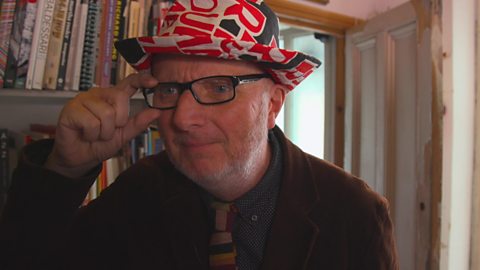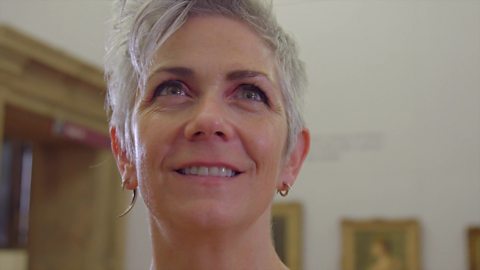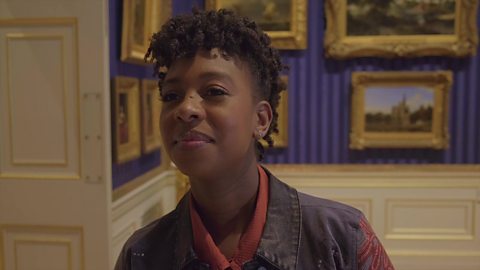RACHEL MARTIN-PEER:
I'm Rachel. I'm a London taxi driver and qualified London tour guide. What I learned when I started to become a taxi driver doing The Knowledge: because we had to learn 23,000 streets and 20,000 places – points as we call them – it's all about visualisation. It's all about recognising what's on the corner of this street, what's on the corner of the next street. So using maps, drawing pictures, all became a really vital part of learning all the streets of London and all of the buildings that I needed to learn as well.
Listen, I'm no great artist, but I wanted to show you how I used shape and pattern to help me learn The Knowledge. How I did it to help me learn all the streets. So I would stop on my bike and I would think, "Okay, I'm at a square." So here's the square. Maybe I might write what the square is inside. St James's Square. That's where we are. Now I know we've come in this way. There's another road here. We go around. There's another road here. It's going to come around here. There's another road here, and then it comes down like that. By drawing it, I would see the shapes that were on the map.
(whispers) Amazing.
Here it is, my absolute favourite picture in the National Gallery. Well, let's have a look. What's happening? What can we see? One thing that stands out for me straight away in this picture, is this man here who is demonstrating. He has got his hand out. Look, he's looking straight at me. He's telling me, "Come! Come in. You're part of this," you know. "Look at the experiment. There's a space here."
What used to happen was, the family would be there, and a scientist would come and visit your house and put on this experiment to show you what the latest things were happening. This is the Age of Enlightenment.
Let's have a look what's going on. We've got this young lady here. She's quite scared by it. Perhaps this young one here is a little bit more inspired. She's not sure what's going on. They've not seen anything like it before.
Look over here. This man doesn't even look like he's terribly interested in the experiment. Maybe he's got other worries.
When I look in the rear view mirror of my taxi and I see the faces and I see the eyes, it's very similar to when I'm looking at the eyes and the faces in this painting. Look at this young man here. He's really interested in it. He wants to learn, he wants to know more. You wonder what are they thinking. Who are they? What are their lives like? And it can stimulate conversation when I'm in the taxi.
And then we look at the clothes they're wearing. It's very much of the age of the 18th Century. We've got a glass jar here and we can see in front of the little girl there's a cork, and we know that that cork goes in that jar, but what's in the jar – there's a quill, a feather quill. A quill is the middle part of a feather, which we used for writing as we know, and they're hollow. In this case, probably being used to show how you can blow bubbles, because this is all new. These are experiments that nobody knew about or took time to understand. This we know is a glass vase and we can see from this glass vase that, that's where the candle light is that's glowingon everybody's faces, and in this glass vase it's suspected that this is a pair of lungs. They've got a feather going into the lungs and we think that that probably represents another scientific experiment.
So one thing I would really love to say to everyone is I've introduced you to a really old friend of mine and I would love for you to find the picture that speaks to you, the one that you love that becomes your favourite.
In this short film for primary schools taxi driver and tour guide Rachel Martin-Peer looks afresh at Joseph Wright of Derby's An Experiment on a Bird in the Air Pump.
Created in partnership with Art UK, this video is part of a collection for primary schools featuring people looking afresh at well-known works of art and exploring how they use the skill of looking in their own lives and careers.
Teacher Notes
This short film can be used as a standalone resource to inspire an Art and Design activity in class, or used as part of a Superpower of Looking lesson.
Click or tap here for a free accompanying lesson plan from Art UK. Art and Design curriculum links across all four national curricula can be found near the top of the lesson plan.

More from The Superpower of Looking:
Ade Adepitan looks at Self-Portrait with Bandaged Ear by Vincent van Gogh. video
In this short film for primary schools Ade Adepitan looks afresh at Vincent van Gogh's Self-Portrait with Bandaged Ear.

Bob and Roberta Smith looks at Surprised! by Henri Rousseau. video
In this short film for primary schools Bob and Roberta Smith looks afresh at Henri Rousseau's Surprised! (also known as Tiger in a Tropical Storm).

Denise Mina looks at The Pink Tablecloth by Henri Matisse. video
In this short film for primary schools Denise Mina looks afresh at Henri Matisse's The Pink Tablecloth.

YolanDa Brown looks at A Boy Bringing Bread by Pieter de Hooch. video
In this short film for primary schools YolanDa Brown looks afresh at Pieter de Hooch's A Boy Bringing Bread.
